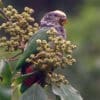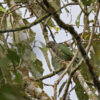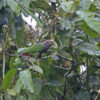White-capped Parrot
Also known as:
White-capped Pionus, White-headed Parrot, Speckle-faced Parrot
Also known as:
White-capped Pionus, White-headed Parrot, Speckle-faced Parrot
DID YOU KNOW?
The eggs of Pionus parrots are proportionately larger for the size of the bird than those of other parrot species.

Pionus

seniloides
Size:
30 cm (11.7 in)
Weight:
229 g (8 oz)
Subspecies including nominate:
one
Colour Adult:
Both adults in general green, lower underparts being paler; white forehead and forecrown, the feathers grey just before the tips and orange/red tipped on forehead; dark grey ear coverts marked with pink; white cheeks and lores, dark grey edging on the feathers; feathers on forecheeks sometimes edged with orange/red; throat has pink band, turning to red/purple on chest and further blending with brown on abdomen; red undertail coverts; green tail with red at base. Beak pale olive/yellow. Eye ring bare and pale grey. Eye brown.
Colour Juvenile:
Feathers on head green with white bases showing; feathers on crown edged with dull red; white sides of head, with margined green feathers; green throat and breast, the feathers with dull red/mauve in centre.
Call:
Calls are described as distinctive; in flight a smooth series of notes with a laughing tone, also harsher notes. While perched calls take on a nasal tone.
More Information:
Content Sources:
Birdlife International
Cornell Lab of Ornithology/Birds of the World
Parrots: A Guide to Parrots of the World, Juniper and Parr, 1998.
Parrots of the World, Forshaw and Cooper, 1977. 2010 edition
Parrots of the World, Forshaw, 2006.
Parrots in Aviculture, Low, 1992.
Parrots: Their Care and Breeding, Low, 1986.
Captive Status:
Rare in aviculture.
Longevity:
25+ yrs
Housing:
Aviary or suspended enclosure, minimum length 2 m (6.5 ft).
Diet:
Fruits such as: apple, pear, bananas, oranges, cactus fruits, pomegranates, forming about 30 percent of the diet; vegetables such as: carrot, celery, green beans and peas in the pod; fresh corn; green leaves such as: Swiss chard, lettuce, sowthistle, dandelion, chickweed; spray millet; small seed mix such as: canary, millet, and smaller amounts of oats, buckwheat, safflower and a little hemp; soaked and sprouted sunflower seed; cooked beans and pulses and boiled maize and complete kibble.
Enrichment:
Bird-safe, unsprayed fir, pine, willow or flowering branches, wooden block toys, vegetable tanned leather toys, foraging/puzzle toys, swings, ladders, ropes. Also provide, for bathing, overhead misters or shallow water bowls.
Nest Box Size:
Vertical box 10″ x 10″ x 20″ (25.4 cm x 25.4 cm x 50.8 cm).
Clutch Size:
4
Fledging Age:
9-10 weeks
Hatch Weight:
—
Peak Weight:
—
Weaning Weight:
—
World Population:
Unknown but described as fairly common. Decreasing.
IUCN Red List Status:
Least Concern
CITES Listing:
Appendix II
As congener of P. tumultuosus.
Threat Summary:
Not globally threatened. Generally uncommon and local. Very little trade internationally. Probably less numerous than formerly conspecific P. tumultuosus, perhaps because the latter’s drier forests tend to produce more fruit than the wet ones where P. seniloides is found. Forest loss is more extensive and especially a major threat to Venezuelan populations. This species is considered to have a medium dependency on forest habitat, and tree cover is estimated to have declined by 1.8% within its mapped range over the past three generations. Therefore, it is precautionarily suspected that this may have led to a 1-19% decline in the species’ population over the same period.
Range:
Mountains of W Venezuela, from Tachira and Merida to Trujillo-Lara border, through W Colombia; in Cordilla Occidental reported only locally on eastern slope of Rio Cauca valley, SW Antioquia and south on both slopes of Andes in Ecuador to NW Peru, in Cajamarca and La Libertad.
Habitat:
Found from 1500-3200 m (4920-10,496 ft) in montane forest and forest margins; also high cloud forest or stunted trees bordering paramos.
Wild Diet:
Feeds on seeds, fruits Turpinia paniculata, Clusiaceae, and sometimes maize.
Ecology and Behaviour:
Gregarious. Seen in flocks of up to 20 birds. More active in grey, cloudy weather conditions. Difficult to see while feeding or resting in upper canopy.
Clutch and Egg Size:
4 broadly elliptical eggs, 35.0 x 25.5 mm (1.4 x 1 in).
Breeding Season:
Possibly November-December. Nest is presumably in a tree cavity.
Related Links:
—
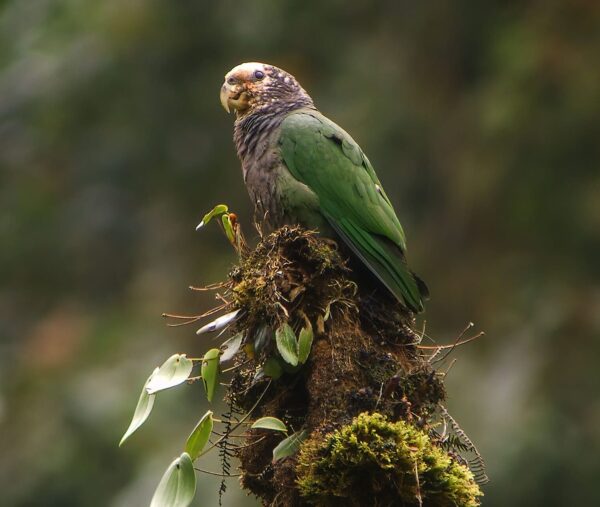
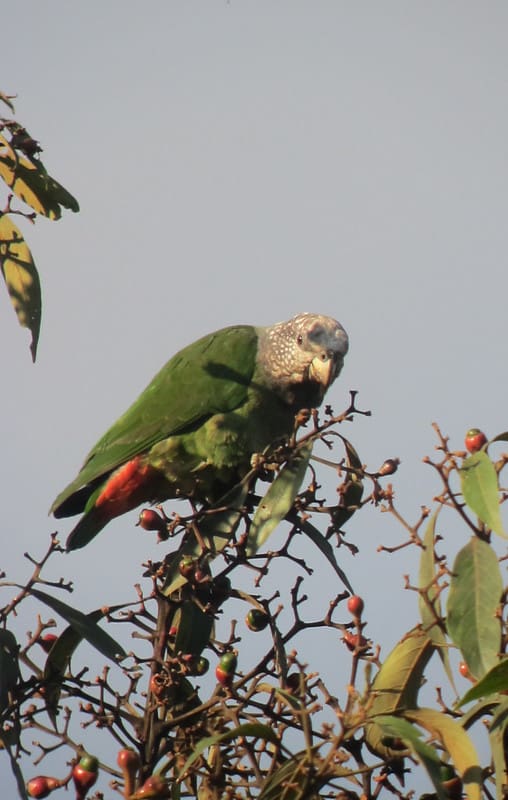
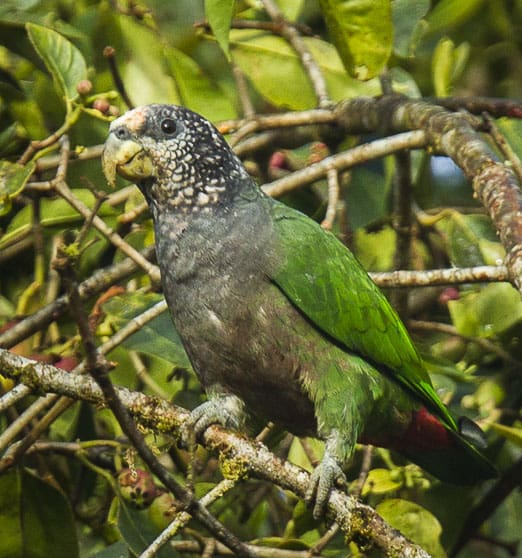
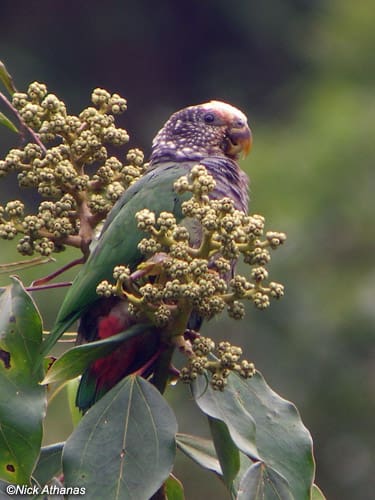
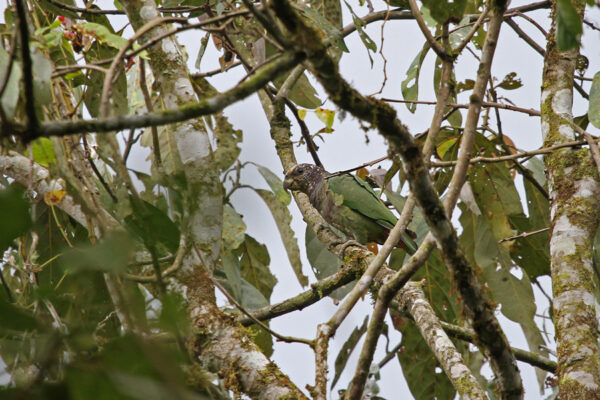
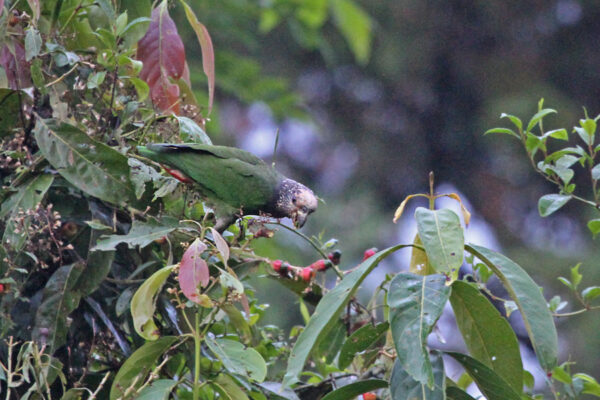
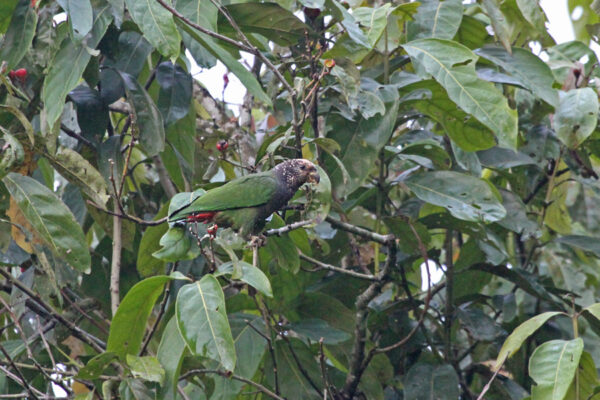
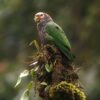
![© Felix Uribe [CC BY-SA 2.0] via Flickr A wild White-capped Parrot feeds on berries](https://parrots.org/wp-content/uploads/2023/01/wpt_White-capped-Parrot_1406-7-100x100.jpg)
![© Francesco Veronesi [CC BY-NC-SA 2.0] via Flickr A wild White-capped Parrot perches in a leafy tree](https://parrots.org/wp-content/uploads/2023/01/wpt_White-capped-Parrot_1406-3-100x100.jpg)
